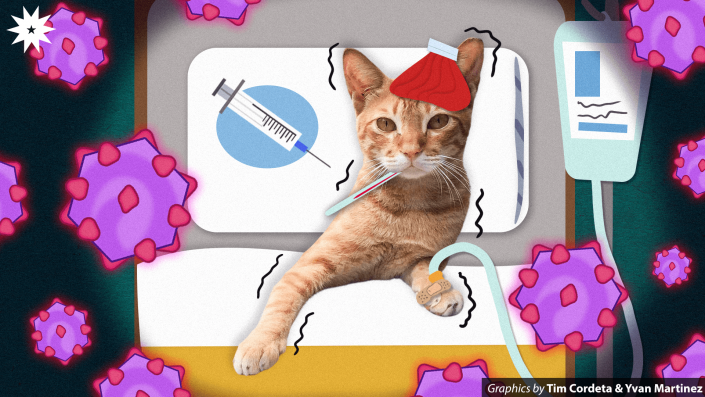In the case of cats, parvovirus remains one of the leading causes of feline deaths around the world. In early September, De La Salle University’s (DLSU) Professors for the Upliftment of Society’s Animals (PUSA) dealt with a raging parvovirus outbreak among the Lasallian cats, leaving 13 felines lifeless in just two weeks. While the disease is common and affects all cats, there is still no cure for parvovirus.

The tale of the virus
Parvovirus is a highly contagious disease prevalent in cats, dogs, and humans. Bridget Arellano, a veterinarian and part-time lecturer from the Department of Biology, states that it stems from two viral families: the parvoviridae subfamily for vertebrates, and the densovirinae subfamily for invertebrates.
There is a variety of genera present under the parvoviridae subfamily, including the canine and feline parvoviruses. Arellano expounds that these viruses have “protective capsules” which allow them to be resistant to inactivation. “They can live in temperatures as high as 50 degrees Celsius, so it’s really hard to kill these viruses,” she posits.
Early clues
As parvovirus is difficult to kill, it can easily spread from one infected animal to another. Laureen Velasco, an assistant professor from the Department of Philosophy and founding member of DLSU PUSA, shares how difficult it was to contain the recent parvovirus outbreak among the Lasallian cats. “We did not realize we were having an outbreak until [kittens] started dropping dead, one after the other,” she says.
While the disease affects both animal and human populations, different strains can only infect a specific species. For example, feline panleukopenia is a parvovirus that only infects cats, and humans are not at risk of acquiring the disease. However, a person who has come in close contact with infected animals can still transmit parvovirus to other animals merely through the presence of the virus on their body parts or garments. Similarly, if a healthy dog or cat is exposed to any surface containing the virus, they are at risk of infection.
Common symptoms of the virus include the occurrence of the “slapped cheek syndrome”—a reddish rash on the cheeks for humans—as well as hemorrhagic diarrhea and inappetence—a loss of appetite—for cats and dogs.
That said, while both parvoviridae and densovirinae parvovirus subfamilies are dangerous to all species, Arellano specifies that younger populations—specifically children, kittens, and puppies—are more susceptible to acquiring it. This is particularly because they exhibit an abundance of energy and curiosity about their environment. “[That’s why] if you have a [rug] or slippers outside and [your pets] chew on it, that’s the time [when the virus] will enter their body,” she illustrates.
As Arellano and Velasco both suggest that prevention is better than a cure, there are also some steps that could be taken to aid the virus. Velasco, for instance, elaborates that a four-in-one vaccine is administered by batch to the cats on DLSU’s campus. To her, vaccination is the “solution [to the parvovirus] and the best way to prevent it.” Arellano adds that this could help them develop antibodies against the virus. “The antibodies can [be transferred] to puppies and kittens so that they would have protection for the first few weeks of their lives,” Arellano articulates. She also proposes thorough handwashing with soap and water, along with practicing proper cough and sneeze etiquette to intercept viral transmission.
Building an inner defense
Without a doubt, parvovirus seems like a nightmare for any cat or dog owner, especially when a handful of their pets share the same living quarters. Nonetheless, early diagnosis and vaccination are key to beating any parvovirus outbreak. If unvaccinated pets do get infected, it is not yet time to lose all hope. Arellano reminds pet owners to be wary of the 24-hour window when pets start showing symptoms. As some symptoms, like diarrhea, typically do not manifest in pets right after infection, Arellano suggests taking cats to the nearest vet as soon as they show inappetence.
This allows veterinarians to catch parvovirus early and begin treatments, such as subcutaneous hydration and intravenous medication before it is too late. To rid pet owners of the parvovirus scare, inoculating kittens and puppies as early as six weeks old could significantly protect them against the virus after two weeks. As vaccination shows the most promise against parvovirus with an over 90-percent efficacy rate, much help is still needed from the Lasallian community to safeguard the cats from the virus. While it is expensive to inoculate all cats with the four-in-one vaccine, Velasco is adamant about continuing such processes as treatments may incur even more costs. To date, DLSU PUSA has not encountered any new cases after regularly vaccinating the Lasallian cats and isolating any panleukopenia suspects. They are still accepting donations from the community to fund vaccinations for the cats.
While parvovirus persists in society, the organization remains hopeful that its recent parvovirus outbreak will be its last. Together with over 400 student volunteers, DLSU PUSA proves that no outbreak can outlast their efforts despite their limited resources. While achieving herd immunity is, by far, a long shot, inoculating one’s dog or cat and isolating the infected can help protect more feline and canine populations—one pet at a time.
